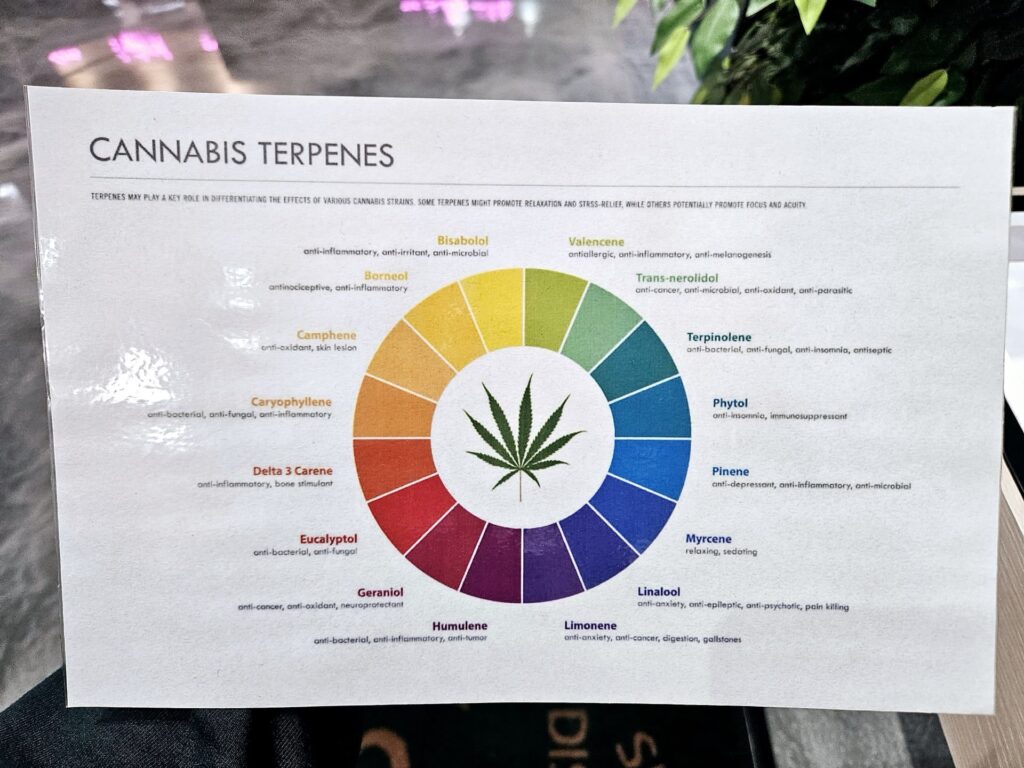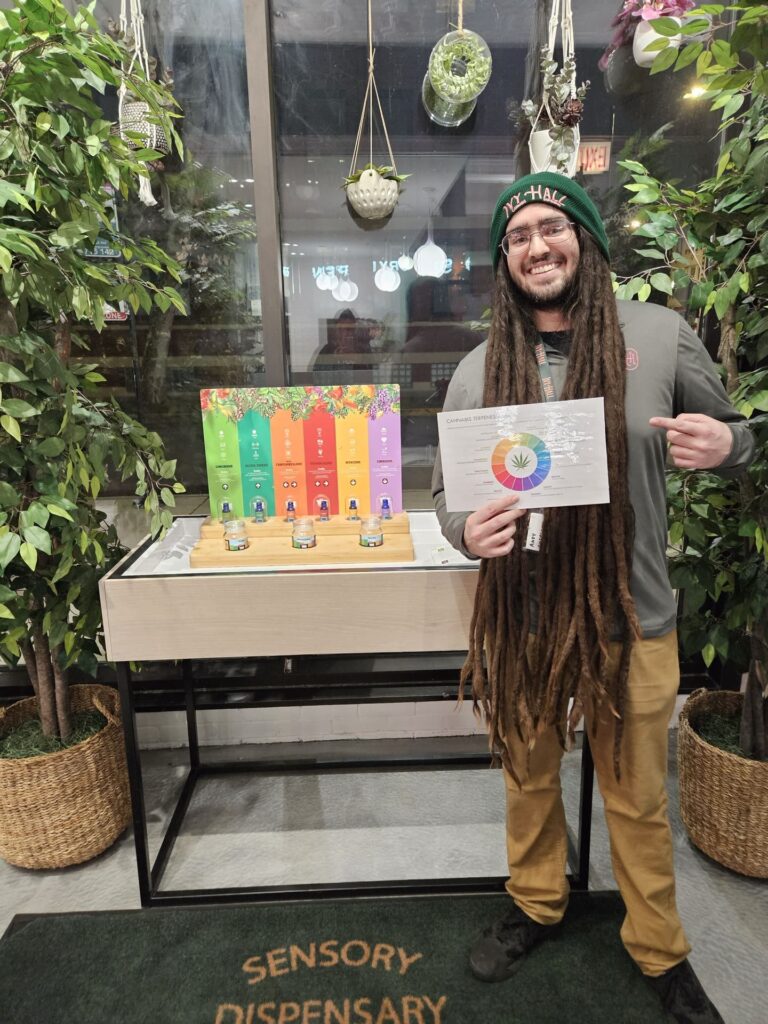Here at Ivy Hall, we enjoy helping our neighbors learn all they can about cannabis. To us, one of the best things about our favorite sensory herb is that there are a plethora of strains at your disposal, practically bursting at the seams with various levels of cannabis compounds. Whether you need to unwind from a hard day’s work, have a chronic medical condition that can be managed with cannabis, or simply enjoy the sensory experience cannabis can provide, it’s the cannabinoids, terpenes, flavonoids, and other compounds that help you get there.
Our team at Ivy Hall is committed to educating you about each of them so you can make the right product choices for your needs and desires. To that end, if you already follow us on social media, you may have noticed our video series exploring all things terpene, aptly entitled “Terp Time.” If not, be sure to check it out on YouTube and subscribe to our channel for future drops!
Today, we have put together a blog that is designed to help you understand terpenes and how this cannabis compound can help you relax, recover, or revel in euphoria.
What Are Terpenes?
Terpenes are natural chemical compounds found in many different plants, including cannabis plants. They give common plants their aromatic properties, including a distinctive smell and even taste. For example, terpenes are what give citrus peels their characteristic tang, pine needles their signature scent, and hops their pungent aroma. Terpenes are thought to serve as protection for plants in nature, repelling predators and attracting pollinators with their strong scents, as well as helping the plant fend off pathogens and fungi. As it turns out, these properties may offer some of the same health benefits to people.
Researchers are diligently studying the way terpenes interact with the body’s natural system of cannabinoid receptors – chemical receptors designed to accept cannabis compounds – known as the endocannabinoid system. While terpenes are not cannabinoids like THC and CBD, some of them do appear to bind with receptors or even interact with cannabinoids themselves to prolong their effects. This means that together, the cannabinoids and terpenes in cannabis appear to create what we call the entourage effect, when the entire entourage of cannabis compounds work in synergy to create the ultimate sensory experience. Terpenes can add an extra sensory and therapeutic layer of effects, and those will vary depending on the terpene in question.
Top Terpenes

There are over 150 different terpenes that can be found across the cannabis Sativa L. family alone. That’s why it is especially important to learn about cannabis terpenes before you select a cannabis product. Each unique cannabis strain can be described by what we refer to as a “terpene profile” – the set of primary terpenes that give the strain a distinctive scent, flavor, and set of effects. When you understand the terpenes that are most active in a potential cannabis product and the potential effects of cannabis terpenes, you can determine whether a strain will suit your taste and your needs.
If you’re wondering what cannabis terpenes to shop for next time you visit us in person, learn more about some of the most prominent below.
Pinene
One of the most prominent and common cannabis terpenes is pinene, which can be found in popular strains such as Blue Dream, Jack Herer, and more. As the name may suggest, pinene is known for its piney, earthy aroma. Many people who enjoy strains high in pinene compare the scent to sniffing a fresh pine trimming, which can be relaxing and inviting to some. Pinene lends lavender, basil, and rosemary flavor notes to cannabis. You may also taste a hint of citrus, like lemon and orange, as well.
Pinene may help address pain relief, as it has anti-inflammatory qualities. This terp also boasts anti-anxiety qualities along with boosting energy and focus.
Limonene
Limonene is an extremely common cannabis terpene often found at the top of terpene profiles, including in strains like Pineapple Express, Jack Herer, and OG Kush. As you may have suspected, this terpene has a fresh, citrusy aroma and is found in several different fruits, including lemons, grapefruits, oranges, and more. The aroma and the chemical properties of limonene can help you stay energized and uplifted as you navigate your day.
Limonene is known for its mood-boosting, anti-pathogenic, anti-inflammatory, and anti-nausea properties. For that reason, strains high in limonene may be advantageous for people with depression, anxiety, or stress. Others may prefer limonene-forward strains to help address heartburn or chronic pain.
Linalool
If there’s one cannabis terpene FAQ we receive more than others, it is “What terpene can help me feel relaxed but not sedated?” Our answer is almost always linalool. This terpene is prominent in flowers like lavender, and if you’ve ever used lavender essential oil or lavender bath products, you’ve had a taste of just how calming and relaxing cannabis high in linalool can be.
Linalool lends an earthy, spicy, and floral scent to cannabis strains and can help calm you down without being overpowering. Some people enjoy the feeling of euphoria during the cannabis sensory experience, and linalool does a great job of balancing euphoria and serenity. Like other terpenes, linalool has anti-pathogenic and anti-inflammatory properties, but its strength as a sedative, pain reliever, and muscle relaxant makes it an especially good choice for many.
If you’re looking for a strain that features linalool, Gone Swishin’ is an excellent option. For more information, watch our video on YouTube.
Caryophyllene
Caryophyllene has a sweet, citrus-like aroma and taste, with a unique hint of pepper, wood, and spice that make it a prominent terpene in cinnamon, basil, and other herbs. Caryophyllene is prized for its medicinal benefits, especially its ability to address inflammation, relax muscles, and enhance pain management. This terpene can also help if you’re struggling with depression and anxiety by boosting your mood and helping you stay energized and focused.
Caryophyllene also appears to have a unique role in apoptosis, the natural process of programmed cell death that helps the body destroy unwanted and damaged cells. When your body does not eliminate these cells, they can eventually cause tumors and other issues. Caryophyllene can induce apoptosis and may have anti-cancer properties.
To experience caryophyllene firsthand, we recommend Kush Mints and Sour Diesel. For more information, watch our video on YouTube.
Myrcene
Myrcene is a common cannabis terpene that can also be found in mangoes, lemongrass, thyme, hops, and more. Myrcene tends to smell peppery and fruity with earthy, “skunky” notes many cannabis enthusiasts enjoy.
Myrcene, like other terpenes, can help you calm down and relax, but it may be especially effective in improving your sleep. Additionally, myrcene contains anti-inflammatory and anti-pathogenic attributes that may benefit those with high blood pressure and intestinal problems. Black Afghan is an ideal strain for those looking to experience the effects of myrcene.
Terpinolene
Terpinolene is one of the least common of the major cannabis terpenes and can also be found in herbs like rosemary and sage. It is unique in that it has a scent similar to a combination of gas, pine, and citrus. The scent and taste are considered very similar and can even serve as a natural insect repellent.
Like caryophyllene, terpinolene may have anti-cancer properties. It also harbors anti-pathogenic and antioxidant effects. When using cannabis high in terpinolene, you may feel more energized, creative, and focused while also feeling a sense of euphoria. Try using strains like Florida Oranges, which is high in terpinolene. For more information, watch our video on YouTube.
Humulene
Another terpene that can be a powerful sedative, humulene, is found in several different pungent flower varieties, as well as hops, cloves, and sage. Humulene is known for its signature woodsy aroma and taste, and can help calm the mind and body when you’re feeling stressed. It can also provide anti-inflammatory, anti-pathogenic, and pain relief benefits. Finally, humulene has also shown promise as an appetite suppressant.
It is crucial to know that this terpene is quite powerful, and you may feel more prone to relaxation rather than physical activity after using a strain high in humulene. If this sounds ideal, try strains like Moon Boots, Skywalker OG, and Sour Diesel.
Ocimene
Ocimene is derived from the Greek word for basil, which is also where ocimene is primarily found. You’ll notice a unique woodsy, herbaceous scent and taste when you try cannabis strains high in ocimene, like Golden Pineapple and Green Crack.
Ocimene is an uncommon cannabis terpene, but it can have a number of benefits for cannabis enthusiasts. When you need a mental boost that helps you feel uplifted, you may be able to benefit from ocimene. Ocimene also has antifungal, anti-convulsant, and decongestant potential.
How to Use the Lookah Glass Seahorse For Your Concentrates
Cannabis concentrates can be a wonderful way to get the full terpene experience, as they are able to express the delightful taste and aroma profile of each cannabis strain. If you’re looking to begin exploring the world of terpenes, the Lookah Glass Seahorse is one of the best ways to start.
The Lookah Glass Seahorse is an electronic nectar collector-style portable dab rig. It features a ceramic coil that heats up your concentrate, a chamber that lets you see the instant vapor it produces and an easy-to-use button that allows you to preheat the coil according to your wishes. To use it, simply press the button three times to preheat your coil. Once you’re ready, apply your concentrate to the coil, wait for the vapor to collect, then inhale and enjoy.
If you haven’t found a favorite concentrate just yet, we recommend beginning with badder-style concentrates. These concentrates have a looser consistency that makes them much easier to work with than other types. All you need to do next is stop into your nearest Ivy Hall Dispensary to experience our Terp Bar, which can help you discover the ideal terpene profile for your badder purchase. For more information, watch our video on YouTube.
How to Use the Terp Bar to Level Up Your High

All Ivy Hall dispensaries feature a “Terp Bar,” which is designed to help you make the cannabis product decisions you need to really level up your high.
The first thing you’ll notice at the Terp Bar are terp jars that allow you to experience the scent of common terps for yourself. You’ll also see a guide similar to a color wheel known as the Aroma Wheel. The Aroma Wheel lists several types of scents, such as fruity, woody, earthy, and more. Then, there are more specific scents listed below to help you refine your preferences. Once you’ve decided which scents you like the most, you can use the color associated with the wheel to select a terpene associated with that scent.
When you’ve found the terpene that interests you the most, you can then head to the kiosk. At the kiosk, you can type in the terpenes you like, and the kiosk will supply the names of several different products that feature this terp. From this point, you can make selections based on the terpenes you chose.
It’s worth mentioning that if you’re new to exploring terpenes, you’ll undoubtedly have additional questions. Cannabis strains feature a mixture of multiple terpenes, and it can be difficult to determine which combination will best suit your preferences. In these instances, it is recommended you approach one of our friendly budtenders and ask questions. They can provide more information about terpenes and help guide you to products that fit your needs.
Come See Us at an Ivy Hall Dispensary Near You Today!

At Ivy Hall, we’re dedicated to providing an end-to-end sensory experience for each person who crosses our threshold. Our Terp Bar, along with our friendly, knowledgeable staff, can help you ensure you are crafting a cannabis session that will fulfill your needs.
Visit us in person at our comfortable neighborhood dispensary to experience terps for yourself, or contact us online to learn more.
Sources:
https://healthsciences.arizona.edu/news/blog/terpenes-cannabis-explained
https://www.nature.com/articles/s41598-021-87740-8
https://www.genome.gov/genetics-glossary/apoptosis
https://pubmed.ncbi.nlm.nih.gov/34638895/
